New Year’s
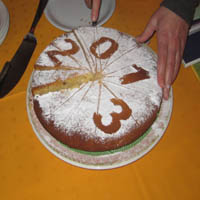
The new year begins with the cutting of “ vassilopita” a special cake with a coin hidden inside. This tradition is followed everywhere in Greece. Associations and unions hold some kind of event giving the chance for having a good time in the middle of the winter.
Epiphany
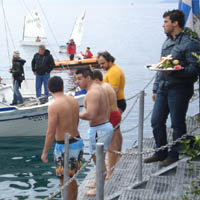
It is a celebration on the 6th of January in memory of the baptism of Jesus Christ in the waters of Jordan River.
After the mass in church, the priest, followed by all the people, goes to the seaside where he drops a cross in the sea to sanctify the water. Young man and women of the village dive in the cold water after it and it is a great honor and blessing for him or her who brings the cross up. After this ceremony, the divers go from house to house where they are treated like guests.
Carnival
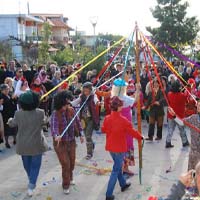
“Tsiknopempti”- a Thursday in the second of the three weeks of carnival- is celebrated at barbecue taverns by the whole family.
The last weekend of Carnival all the towns and villages have some events, a parade or a dance around a pole (like the Maypole) to celebrate the last days of the carnival. People dress up in different costumes and have fun.
The last event, the scurrilous carnival, takes place at Agia Anna on Ash Monday. People there are celebrating using free and dirty language, a tradition that goes back to the ancient Dionysian feasts.
On “Clean Monday” as we call it, we celebrate the start of the fasting period with special vegan dishes – no meat for 40 days. We also fly kites on the beach. In Rovies you can watch the traditional dance “how to grind pepper”.
25th March
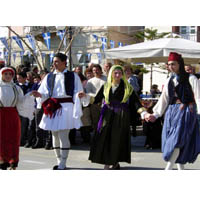
In Rovies, after church, the kindergarten and elementary school children parade through the village to celebrate the rising of the enslaved Greeks against the Turks in 1821.
In Limni the high school students as well as the boy scouts march in front of the town officials.
The students, some of them wearing traditional costumes, then form circles and dance traditional Greek dances. The crowd soon joins in.
Holy week and Easter
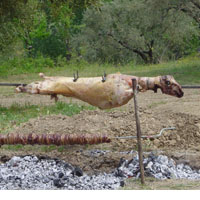
Both regular and fasting dishes you will find at the taverns in the area.
On Good Friday, after the evening mass, you can follow the procession of the Epitaph in Rovies under the light of small lanterns along the way.
On Holy Saturday the mass celebrated for the Rising of Christ starts at about 11:00 pm. On 12 midnight the priest and the faithful around the church shout “Christos Anesti” –Christ is Risen- and light each others’ candle from the holy light brought from Jerusalem.
For your dinner on Holy Saturday (Greek have it after midnight) you may have to reserve a table.
An experience you shouldn’t miss is the burning of Judas and the flying of air-balloons at Agios –near Edipsos- on Easter Sunday
"Easter is the greatest holiday in the Orthodox Church. It is celebrated according to a prescribed set of rituals, beginning with Good Friday funeral processions, peaking with Resurrection service at midnight on Saturday and relaxing into a bucolic lamb-roasting party the next day. Epitaphios or funeral procession starts about 8 and everyone carries a bee wax candle and talks in whispers...
Midnight on Saturday is a magical moment. The churches are packed, the squares outside them brimming with expectant latecomers, each one clutching an unlit candle. At the first stroke the priest emerges from the darkened church with a lit candle and proclaims the eagerly awaited words, Chistos anesti (Christ is risen). As the flame moves from the priest taper through the congregation’s candles, rockets flash, firecrackers explode, and the church bells peal exultantly. A few of the faithful try (in vain) to sing the wonderful Easter hymn against the commotion...
Traditionally, the midnight meal consists of red eggs, feta cheese and magiritsa, a rich egg-lemon soup made of lamb innards, spiting onions and drill...
The lamb itself is eaten the following noon. Usually the men of each clan are responsible for the cooking: they skewer the lamb and sew up its belly, often stuffing it with thyme sprigs and halved lemon or two; they dig the barbecue pit in the courtyard, fill it with charcoal and heroically rise to light it just a few hours after the midnight meal has ended.
By nine or ten o’clock one man will be turning the lamb slowly, while a squad of others offer helpful remarks, discusses soccer team scores or make baleful predictions about the weather, before setting in for their pastime, bashing the government. From time to time a woman will dart from the kitchen with a plate of bread and cheese refilling coffee cups until the men decide to shift to wine, ouzo or tsipouro (usually no later than eleven)..."
...from ‘Prospero’s Kitchen By Diana Farr Luis and June Marinos.
1st May
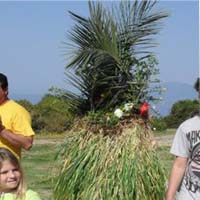
The custom of “Piperia” – pepper- is celebrated in almost all of northen Evia.
A man from the village is covered with green boughs, a bell hanging from his neck. He is the ‘pepper’. Another man follows carrying a hoe on his shoulder. He is the ‘farmer’. They are followed by children and adults singing the pepper tree song. They stop at every doorway where the head of the family sprinkles the ‘pepper’ with water, gives some sweets or change to the two of them and they leave for the next house.
This is to bring rain in May and a good crop.
On the outside of our main door we hang “May” a wreath made of flowers.
27th May
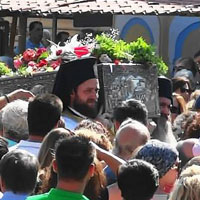
May 27, 1730 is the day of the burial of Agios Ioannis (Saint John) and his memory is celebrated on this day. The mass starts in his church on the evening before and goes on through the night (like a wake) to the next day. The holy remains and the icon of the saint are carried along the streets of Prokopi, which are strewn with rose petals.
The most affecting sight though is the thousands of worshippers, who come on foot to kneel in front of the holy icon. They walk from Halkida, Psahna, Limni, Rovies for 6, 8 or even 10 hours to honor “their own” Saint as they call him, helper and protector.
23rd August
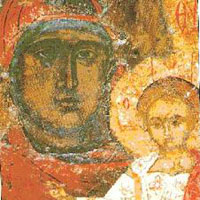
On the road from Istiea to Artemisio after the village Sinaso, ther is a road on the right which leads to the church of Holy Mother Mary Dinius situated among plane trees. On August 23 a big festival and celebration takes place there.
The word “dinius” means return in Turkish and, according to the legend, a Greek sought refuge in the church to escape from a Turk who was after him. The Turk found him and, without respecting the sacred of the place, shot at him. However the bullet hit the icon and returned killing the Turk instead of the Greek.
“Klidonas” - 23-24 June
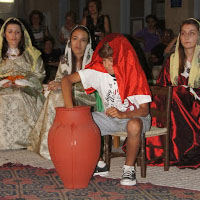
This is a custom that has its roots in the ancient times. It is a popular guessing process where it is showed which young girl will marry first, the type of husband etc.
The evening before Saint John’s day all unmarried girls have a small personal item in a pot. The pot will lay all night under the starlight. On the day of Saint John in the evening the whole neighborhood gathers around the pot.
One girl or boy starts taking out of the pot one item at a time.
The young woman who recognizes it as belonging to her stretches her hand to receive it shouting “it’s mine, it’s mine”.
Older women in the group sing verses which have been composed right then about the luck of the unmarried ones whose personal item is being picked from the pot. If the couplet is nice or fits the girl, there are lot of congratulations and happy screaming.
Panagia Limnia
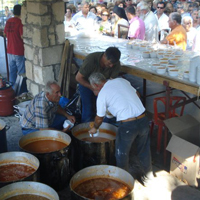
Each year on September 7th, after the evening mass at the Cathedral of Limni, the Icon of our Lady Mary is transferred to Alonia where all the people of Limni are gathered. There they hold an auction for the icon. The highest bidder may carry the icon around the town, which is a great honor. The money goes to the church for the poor people.
The icon is being carried to her Mother Anna, at a small church in the outskirts of Limni, where it says through the night.
The next day- Sep 8th- after the mass the priest blesses the large pots full of food and everybody enjoys a meal outside the church. In the afternoon the icon returns to Limni where there is procession with everybody following the icon on foot while sailboats and kayaks follow along the sea shore.
The local trade stars at the same time.
26th and 28th October
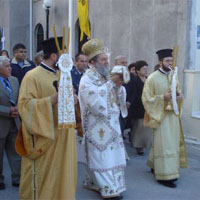
In Rovies on the 26th we celebrate the name-day of our patron saint Dimitrios and on the 28th which is a national holiday we have a parade. It is the anniversary of the “ohi”- no- against the Italians and Germans invasion in 1940.
THE STORY of TSIPOURO and TSIKOUDIA - in November
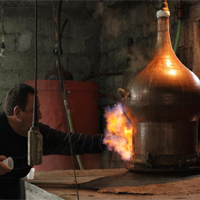
It is a fairy tale that has everything: A benevolent mother who cares for her children (the land with vineyards that produce the grapes), good fairies (fermentation) and evil magicians (souring) fighting who will dominate. Magic and elves (transformation of the must into wine), dragons that breathe fire and faint (cauldron distillation) and, finally, redemption, the wonder, the tears of the Virgin (the pure spirit flowing from the stills). And all this rigged in a smoky scene with dim lighting, a makeshift warehouse on the edge of the courtyard, on cold winter nights, accompanied by laughter and songs.

